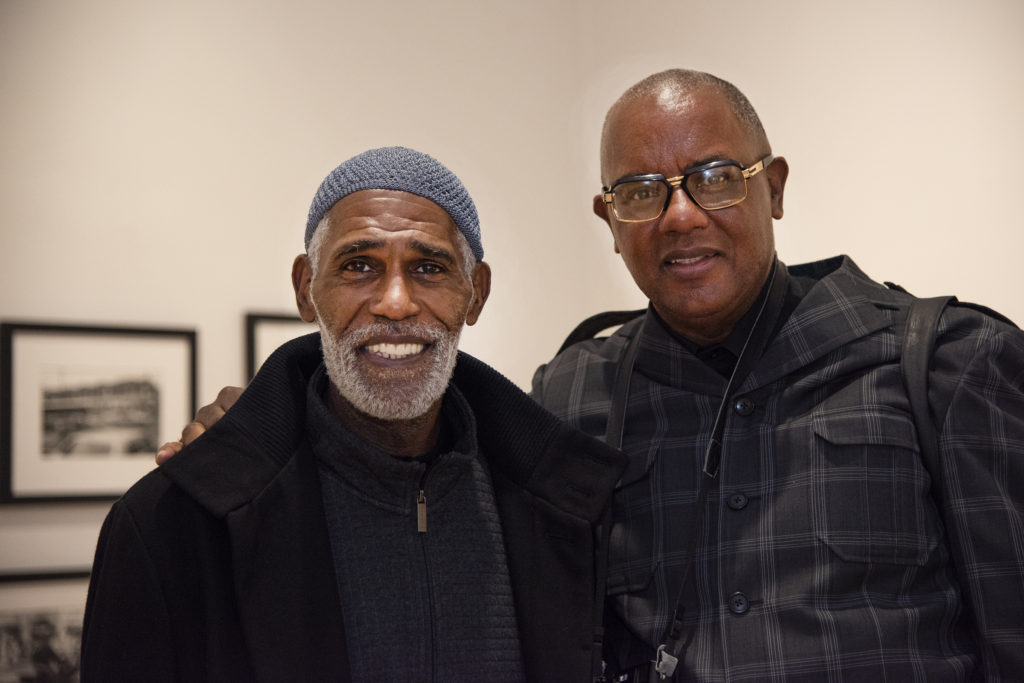
Photo by José A. Giral
A steady stream of family members, friends, and fans fill up the Bronx Museum of the Arts one hour before the exhibit, “Eyes on the Street” opens for a private reception at 6 p.m., on Tuesday, April 5. The retrospective exhibit reviews four decades of photographs from Jamel Shabazz.
“It’s a joy to be here in The Bronx,” Shabazz told Norwood News at the exhibit’s opening. “This great institution has always been so kind to me. It’s the Bronx Museum that gave me one of my most important shows about, maybe, 15 years ago…. They’ve always respected the work I’ve done [so] I’m honored to be here.”
The body of photographic work Shabazz has created is impressive. His work clearly resides within the genre of documentary, and in the subcategory of street photography. The exhibit also works as a historical record of how New York City has changed since 1980. Curated by the museum’s own Sergio Bessa, the exhibit covers Shabazz’s career from 1980 to 2020.
The photographs from the ‘80s will certainly elicit smiles and chuckles from visitors too young to remember a time when Kangol hats, Adidas track suits, and Cazal glasses dominated urban styles. But although the clothes and accessories have changed, where Shabazz excels is at capturing the humanity he sees in front of his lens.
A common feature throughout his photographic journey is how often the people he photographs appear at ease as he clicks his shutter. Historically, street photography has often focused on the more tragic or seedier sides of life, whether it be homelessness, drug abuse, or crime. Conflict and tension are also often key components in the work of influential documentary photographers like Leonard Freed and Gordon Parks, who Shabazz credits with inspiring some of his work.
In March 1968, a story titled, “A Harlem Family” appeared in LIFE magazine with both photographs and text by Parks, described by National Geographic as “one of the 20th century’s most influential interpreters of African American life and culture.”
A current summary of the Harlem Family story describes the faces of the profiled family as “showing despair, anguish, bone-deep weariness, and a grim perseverance.” Parks wrote in 1968, “For I am you, staring back from a mirror of poverty and despair, of revolt and freedom. Look at me and know that to destroy me is to destroy yourself…. I, too, am America. America is me.”
Parks was a master of photography and was just as famous for capturing high fashion models on the pages of LIFE magazine. However, his documentary work, at least the work for which he is most known, captures a Black America exhausted from “poverty and despair.”

Photo by José A. Giralt
Shabazz, on the other hand, walks the streets of some of the most poverty-ridden neighborhoods of the five boroughs, and gets the mostly teenage and young adult subjects to preen, primp, and in general, assume a pose of confidence and bravado.
The streets he walked display a fresh style, rich in originality, but his interactions with his subjects seem to elicit a positivity that is rarely associated with street photography.
On Instagram, Shabazz has over 148,000 followers. One of them, Carmelo Nieves, was at the show’s opening to support the photographer who has, in turn, inspired him and others. “I want to be Jamel Shabazz,” Nieves said, before letting out a good-natured laugh. At 45, he met Shabazz in 2018 at Photoville, a free, annual, outdoor photo festival held by Brooklyn Bridge Park.
As a fellow street photographer, Nieves looks to the work of Shabazz as a source of inspiration. “I finally got to meet him at Photoville [and] one, it was an honor,” Nieves said. “I want to emulate what he does but just take it to another level.”
Working as a corrections officer on Rikers Island gave Shabazz a visceral view of how life on the streets can become a terrible turning point for some, drawing them into crime. Bedford Park resident, Earl Gray, spent years as a fellow officer with Shabazz, both rising to the rank of captain.
“We shared our correction’s journey together,” Gray said. Both men, now retired from the department, have known each other since the 1980s. “[Photography] was his dream; that was his passion,” said Gray. “That’s where his love is.”
The photographs from the 80s will also remind viewers of the abundance of empty lots filled with garbage, subway cars covered with graffiti, and children jumping on discarded mattresses as a leisure activity. But, it is our common humanity that ties the faces and places together, the need to play, to socialize, to feel like our lives matter, and are worthy of being captured for posterity. It was a necessity in 1980, as it is through 2020, and today.

Photo by José A. Giralt
However, Shabazz is not tethered to the past as if his greatest moments are memorialized in gelatin silver or chromogenic prints. When asked for his fondest memory of his photography tour in The Bronx, Shabazz quickly responds, “It would have to be today.”
Acknowledging that the City is going through another rough time, he’s grateful to have this exhibit shown in the borough. “This would be one of the greatest memories I have about The Bronx, to be here in 2022, with everything going on in the City and the world, and see people come together in a spirit of love and unity.”
Jamel Shabazz: Eyes on the Streets is showing through Sept. 4. It is part of the 50th Anniversary celebration of the Bronx Museum of the Arts.




